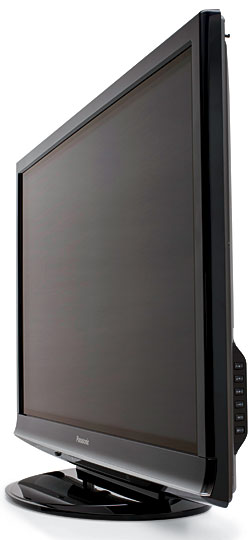Panasonic Viera TC-P42G10 Plasma HDTV Page 2
 The Nitty Gritty
The Nitty Gritty
The Panasonic was clearly the judges’ favorite, and everyone rated it first or second. It pulled in first-place finishes in the composite scores (including ties for color and shadow detail) in three of the four main performance categories. It finished second only in black level and not by much.
If the set has a downside, it’s the lack of gray scale adjustments in the user menus, although this might also be regarded as a plus, as it prevents tampering with a good calibration. I’d also like to see Panasonic offer a good color management system.
Also, as with plasmas in general, the Panasonic isn’t as bright as most LCDs. Still, we found it more than sufficient here, especially in a level playing field with the other sets adjusted for comparable output. It also draws more power than the LCDs. While current Panasonic plasmas are better than those of past years in this respect, LCDs are typically better still.
The Panasonic was generally thought to look its best in a dimly lit or (as in the panel test) a fully darkened room. It deteriorated to worst in show with the overhead lights on.
Everyone on the panel liked the Panasonic’s blacks, although some favored them more than others. One rated them a solid 10 out of 10, two others a 9. “This one and [the Sony] ran circles around the others for blacks and shadow detail,” gushed the 10-rater, who also saw “excellent blacks on Dark Knight… [and] best of the blacks on the Stargate scene.” Another commented on the latter scene as well, noting that while one other set’s blacks were deeper behind the star field (the Sony), the stars were brighter on the Panasonic. Only one judge was a bit luke-warm, offering faint praise. “Pretty good black level for this bunch of sets,” he wrote, “but I’d still prefer darker.” No doubt, this was a recovering Pioneer KURO junkie.
Shadow detail also earned praise, scoring below 9 from only one judge. “Looked crazy-good…especially in the beginning scenes [in Spider-Man] where Spider-Man is flying around the dark city streets,” wrote one. “Blacks almost as good as on [the Sony],” wrote another, “but [the Panasonic] has better shadow detail.” However, he allowed that perhaps the Panasonic’s blacks might have been able to show that detail because its blacks were slightly elevated compared with the Sony. One panelist rated the shadow detail as middling, neither the best of the group nor the worst. Another thought it was the best of the group and rated it highly, but he still said that it didn’t blow his socks off.
 The Panasonic drew mixed comments for its color, but it still managed to tie for first in this category and drew respectable scores. Its calibrated palette stood out among all the sets, and while some liked this, others did not. “Color slightly different than the others, more muted,” wrote one panelist. “Best color so far,” scribbled another. “Greens in Fly Away Home look natural, if maybe the slightest bit lime in the brightest shots.” But the dissenter thought the colors had a greenish/yellowish cast in Seven Years in Tibet (a Blu-ray transfer with exceptionally natural color). He saw a strong blue cast in one of the Stargate clips but commented on the very natural reds, with Spider-Man’s suit almost crimson. Indeed. I was surprised that more of the panel didn’t comment on these crimson-looking reds, which were also obvious on Amy’s red jacket in Fly Away Home. They were far different from the relatively similar reds on the other sets. The question is, which is right? (For more comments on this, see “HT Labs Measures.”)
The Panasonic drew mixed comments for its color, but it still managed to tie for first in this category and drew respectable scores. Its calibrated palette stood out among all the sets, and while some liked this, others did not. “Color slightly different than the others, more muted,” wrote one panelist. “Best color so far,” scribbled another. “Greens in Fly Away Home look natural, if maybe the slightest bit lime in the brightest shots.” But the dissenter thought the colors had a greenish/yellowish cast in Seven Years in Tibet (a Blu-ray transfer with exceptionally natural color). He saw a strong blue cast in one of the Stargate clips but commented on the very natural reds, with Spider-Man’s suit almost crimson. Indeed. I was surprised that more of the panel didn’t comment on these crimson-looking reds, which were also obvious on Amy’s red jacket in Fly Away Home. They were far different from the relatively similar reds on the other sets. The question is, which is right? (For more comments on this, see “HT Labs Measures.”)
The Panasonic also topped the group in its resolution. In fact, there were few comments on this, apart from the high numerical scores. But one judge remarked on the good detail in Heath Ledger’s face in Casanova. Others also noted the set’s lack of motion blur, although one panelist felt that the motion was slightly more juddery than the others. This might be traceable to the fact that the Panasonic was running at a frame rate of 60 Hz with 3:2 pulldown, as noted above.
Conclusions
There’s not a lot to say here, since the Panasonic nearly ran away with this Face Off. Only the Sony issued a strong challenge. In the raw scores, the Panasonic grabbed nearly 10 percent more points than the second-place Sony, 28 percent more than the third-place LG, and 43 percent more than the Toshiba. It was also the clear value leader.
If you don’t need the extra brightness that an LCD can provide and you do most of your serious viewing in a room with subdued lighting, this could be your new flat-panel set.














































